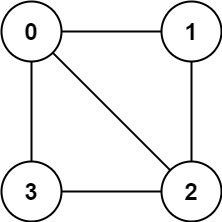color flip, 886,785
We want to split a group of n people (labeled from 1 to n) into two groups of any size. Each person may dislike some other people, and they should not go into the same group.
Given the integer n and the array dislikes where dislikes[i] = [ai, bi] indicates that the person labeled ai does not like the person labeled bi, return true if it is possible to split everyone into two groups in this way.
Example 1:
Input: n = 4, dislikes = [[1,2],[1,3],[2,4]] Output: true Explanation: group1 [1,4] and group2 [2,3].
Example 2:
Input: n = 3, dislikes = [[1,2],[1,3],[2,3]] Output: false
Example 3:
Input: n = 5, dislikes = [[1,2],[2,3],[3,4],[4,5],[1,5]] Output: false
Constraints:
1 <= n <= 20000 <= dislikes.length <= 104dislikes[i].length == 21 <= dislikes[i][j] <= nai < bi- All the pairs of
dislikesare unique.
解题思路:
1.将dislike建图
2.对所有节点进行dfs遍历,每次传递并且切换颜色,如果传入的期望颜色与已标颜色出现冲突,说明不满足条件
class Solution { public boolean possibleBipartition(int n, int[][] dislikes) { //build graph 建图 List<Integer>[] graph = new List[n+1]; for(int i=0;i<=n;i++) graph[i] = new ArrayList(); for(int[] dislike : dislikes){ int left = dislike[0],right = dislike[1]; graph[left].add(right); graph[right].add(left); } //init color array int[] colors = new int[n+1]; Arrays.fill(colors, -1); int count = 0; for(int i=0;i<=n;i++){ if(colors[i]==-1){ if(!dfs(graph, colors, i, 0)) return false; } } return true; } private boolean dfs(List<Integer>[] graph, int[] colors, int curr, int color){ if(colors[curr]!=-1){ if(colors[curr]==color) return true; else return false; } colors[curr] = color; for(int other:graph[curr]){ if(!dfs(graph, colors, other, 1-color)) return false; } return true; } }
There is an undirected graph with n nodes, where each node is numbered between 0 and n - 1. You are given a 2D array graph, where graph[u] is an array of nodes that node u is adjacent to. More formally, for each v in graph[u], there is an undirected edge between node u and node v. The graph has the following properties:
- There are no self-edges (
graph[u]does not containu). - There are no parallel edges (
graph[u]does not contain duplicate values). - If
vis ingraph[u], thenuis ingraph[v](the graph is undirected). - The graph may not be connected, meaning there may be two nodes
uandvsuch that there is no path between them.
A graph is bipartite if the nodes can be partitioned into two independent sets A and B such that every edge in the graph connects a node in set A and a node in set B.
Return true if and only if it is bipartite.
Example 1:

Input: graph = [[1,2,3],[0,2],[0,1,3],[0,2]] Output: false Explanation: There is no way to partition the nodes into two independent sets such that every edge connects a node in one and a node in the other.
Example 2:

Input: graph = [[1,3],[0,2],[1,3],[0,2]]
Output: true
Explanation: We can partition the nodes into two sets: {0, 2} and {1, 3}.
Constraints:
graph.length == n1 <= n <= 1000 <= graph[u].length < n0 <= graph[u][i] <= n - 1graph[u]does not containu.- All the values of
graph[u]are unique. - If
graph[u]containsv, thengraph[v]containsu.
解题思路:
跟上一题类似,但是记得把所有点都过一遍,以免不联通的图 漏掉一些group
class Solution { public boolean isBipartite(int[][] graph) { int[] color = new int[graph.length]; Arrays.fill(color,-1); for(int i=0;i<graph.length;i++){//坑点,有可能这个图压根就不连通,因此需要把所有点都过一遍 if(color[i]==-1){ if(!dfs(graph, i, color, 0)) return false; } } return true; } private boolean dfs(int[][] graph, int node, int[] color, int nextColor){ if(color[node]!=-1 ) return color[node]==nextColor; color[node] = nextColor; for(int other:graph[node]){ if(!dfs(graph, other, color, 1-nextColor)) return false; } return true; } }





 浙公网安备 33010602011771号
浙公网安备 33010602011771号